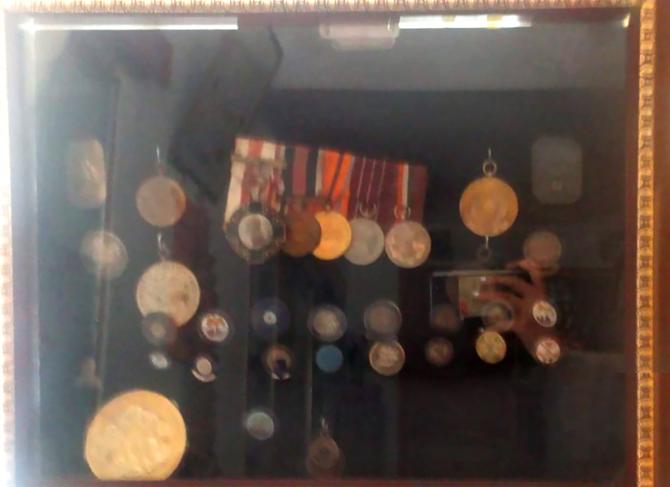'Nanda Devi is not an easy mountain to climb.'

Sonam Wangyal, the legendary mountaineer, along with other Central Reserve Police personnel were ambushed at Hot Springs on October 22, 1959 by Chinese soldiers in an incident reminiscent of how Colonel Babu along with soldiers of the Bihar Regiment were ambushed by the People's Liberation Army in the Galwan Valley on the night of June 15, 2020.
Wangyal feels blessed that he came out of that ambush alive as also that he succeeded in climbing Mount Everest at the age of 23 since he had never dreamt of becoming a mountaineer.
Today, at 79 years, Wangyal regrets how the PLA have encroached on large parts of Ladakh. The concluding part of a two-part interview with Rediff.com contributor Rashme Sehgal.
No, I never had the opportunity.
Climbing mountains has become much more expensive today. I did get a chance to fly over Everest. The trip was sponsored by the Nepalese government. It was done to commemorate 25 years of our group climbing Everest.
Mountaineering has also changed in all these years.
Glaciers have shrunk. The snow line has moved up, the snow has thinned. It is no longer the thick blanket of snow that we walked through.
This is all part of global warming.
Our Buddhist texts have written that a time will come when all our water sources will dry up and there will not be a drop of water left to drink in these mountains.
Already, the summers have become much longer in Ladakh. Earlier, we would get rain in Ladakh. Now we do not get even a drop.

Yes. After my matriculation, I took up a job as a primary school teacher. One year later, I joined as a clerk in the local forest department.
A year later, I quit that job and joined the ITBF as a surveyor and found myself posted near the Chang Chenmo river valley located near the India-China border.
I was attached to the Central Reserve Police and we had to keep an eye on Chinese movements.
On October 21 1959, our team was ambushed by the PLA in an encounter, which is similar to the way the Chinese soldiers ambushed Colonel Babu and his contingent of soldiers.
We used to patrol on the Indian side when on October 19, 1959, six members of our team were sent out to patrol, but only four returned.
A group of us including myself were deputed to search for them, but we could not find them.
On October 20, again we went out looking for them and could not find them.
On October 21, we set out with a large search party comprising around 40 men largely from the Central Reserve Police (later, called the Central Reserve Police Force).
We were armed with old outdated .303 rifles when we were fired upon by Chinese soldiers who were hiding behind bunkers and were armed with machine guns and carbines.
We lost ten soldiers while another ten were taken captive who were later released.

This happened in 1965 soon after we had successfully climbed Everest.
The ambush in Hot Springs occurred in 1959. Please do not confuse the two events.
Four Indians were selected to go to Alaska for training on a secret mission, but we were not told any details about it. The four selected were Captain Kohli, Harish Rawat, Gurcharan Singh Bhangu and me.
All four of us had been part of the Everest expedition. The India-Pakistan War in 1965 cut short our training in Alaska and we returned early.
The following year we had to carry this device and leave it at the Nanda Devi summit.
At that time, we had no idea about what it was except that it was a heavy power unit that would provide the government information on Chinese movements.
Nanda Devi is not an easy mountain to climb and the device weighing 56 kilos was carried by porters on their back.
But before we along with our American counterparts could reach the summit, the weather turned bad and so we decided to leave the device and then come back the following year and activate it.
The next year we returned to the same place. We searched, but it could not be found.
In 1967, all four of us and the American mountaineers climbed Nanda Kot and left the second device there.
The following year, this developed some mechanical problem.
So in 1968, we went back to Nanda Kot to retrieve the device.
The Americans took the device at the Nanda Kot base camp, put it in a chopper and flew it directly to Delhi.
All the details of this expedition have been given in Captain Kohli's book, Spies in the Himalayas: Secret Missions and Perilous Climbs. You must read it. (The device included a stock of plutonium which was about half the size of the atomic bomb dropped on Hiroshima).

That was way back in 1960, when I became a member of the ITBF mountaineering team and we were deputed to climb the Stok Kangri mountain.
I have been recovering from typhoid which I developed when I was in Dehra Dun. I got held up there because of the lockdown.
I am very keen to set up a mountaineering institute in Leh. The land has been allotted to us, but further work on it has got held up because of covid.
It is called the Ladakh Mountaineering and Adventure Club and we hope this institute will keep the spirit of mountaineering and adventure alive amongst Ladakhi youth.
Feature Presentation: Rajesh Alva/Rediff.com











 © 2025
© 2025